Kotor, Montenegro: Old Town Charm in Europe’s Most Spectacular Scenery
In this destination trip report we will visit the city of Kotor in Montenegro, where a picture-perfect Medieval old town meets some of the most spectacular scenery to be found in Europe.
Montenegrin coast
The Montenegrin coast has long been a popular destination with tourists from across ex-Yugoslavia and the rest of Europe.
Many head to the resort towns of such towns as Herceg Novi, Ulcinj and perhaps most notably Budva.
There is however much more to the coast of Montenegro than beaches alone.
The jewel in the crown of the Montenegrin coast is the city of Kotor, which is famous for its picturesque walled old town and its dramatic setting right at the foot of some imposing mountains.
Kotor has long been one of my favourite travel destinations in Europe and I was delighted that I finally had the opportunity again to return to the city.
Old town walls
The walled old town of Kotor has three main entrance gates.
There is the sea gate facing the yacht harbour on the western side, the southern gate and the north gate. The eastern side of town faces a steep mountain flank.
When arriving from the bus station located just south of the old town, the impressive fortified south gate is the first entry point you reach.




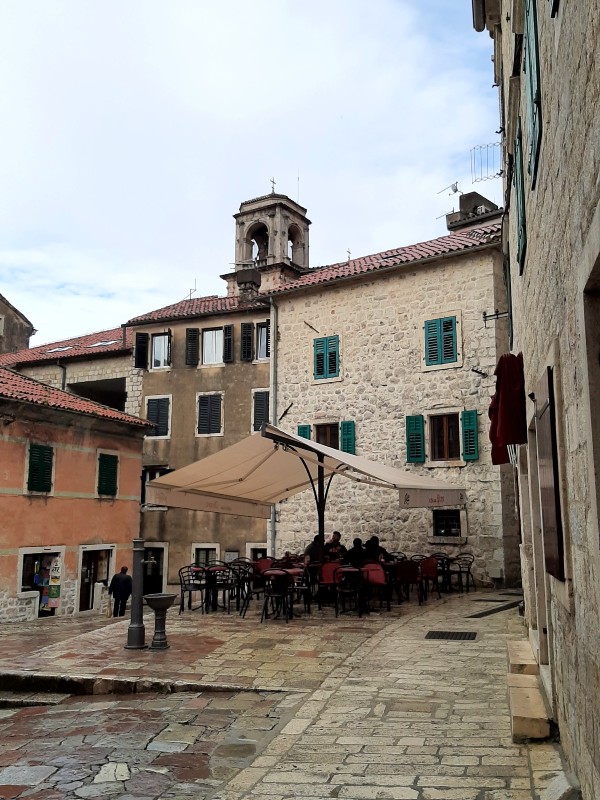
Exploring the old town
Kotor’s old town (called ‘Stari Grad’ in the local Montenegrin language) looks and feels a bit like the Croatian city of Dubrovnik located just a a few hours away by bus to the north-west.
It has the same style Medieval architecture and shares a similar history as fellow Adriatic Sea power.
At times, Kotor and Dubrovnik were rival cities with its traders and seafarers jockeying for influence.
However, during long parts of history both cities were themselves conquered by larger outside powers such as the Venetians, who left behind a lasting influence in Kotor.
Compared to Dubrovnik the old town of Kotor is however much more compact and smaller in size, making it easier to explore.
A big part of Kotor’s charm is to simply wander through the atmospheric streets of town, admiring the old stone mansions and piazzas you come across.


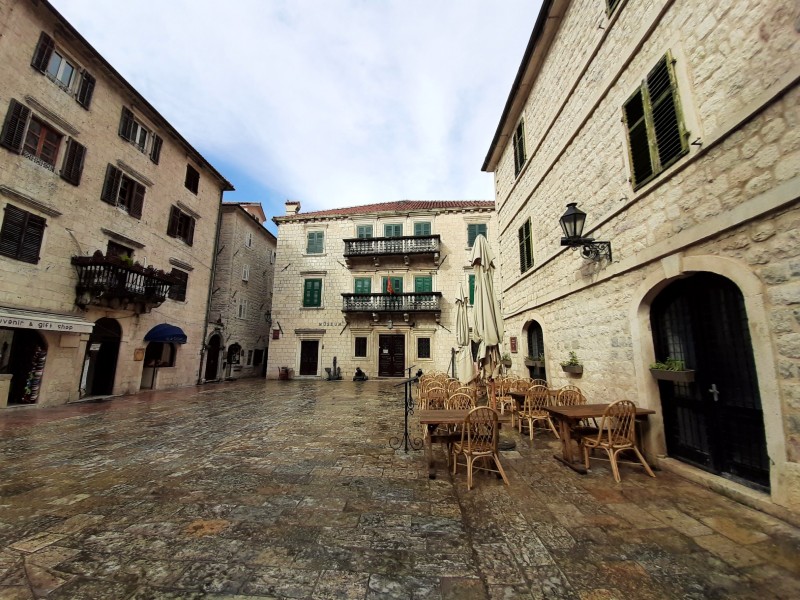

Sea Gate
One of the other main gates of Kotor is the west-facing Sea Gate, which faces the marina where some yachts and (in season) small cruise ships are docked.
Above the Sea Gate you can find a relief of the old communist Yugoslavian coat-of-arms and a quote by Tito.
The quote (“tude necemo svoje ne damo”) translates to “what belongs to others we don’t want, what is ours we will never surrender” and refers to the resistance of Tito’s Partisans against the Nazi occupiers of former Yugoslavia.
The date above the gate (21st November 1944) refers to the liberation of Kotor in the Second World War.



A quick lunch
Although there are quite a few appealing cafes and restaurants in the old town of Kotor, there aren’t that many spots at all where you can grab a snack.
As I was getting quite hungry but did not want to sit down for a drawn-out meal, I therefore headed out of the old town to a nearby butcher which doubles as a small eatery.
Located around five minutes walking distance away from the Sea Gate, BBQ Tanjga as it is called has some mouthwatering, huge steaks on offer.
Although I did for a minute consider taking one, I settled on something smaller in the end as I went for some pljeskavica.
Pljeskavica is the name for the Serbian-style hamburger and is one of Europe’s best fast food dishes you can eat.
It is basically a spiced meat patty mixture of pork, beef and lamb which is then grilled and served in a flatbread
To eat it the proper Balkan way, you just need to add some raw onions and sprinkle it with some peppery condiments.
Adding kajmak (a kind of clotted milk cream) is also popular.

Main square
After the tasty lunch I headed back through the Sea Gate into the old town.
If you enter Kotor’s old town through this gate you will find yourself on a square called Trg od Oružja, which basically means “The Arms Square”.
The square’s name is derived from Venetian times as back then the ammunition and gunpowder of the city’s garrison was stored here.
Nowadays the most dangerous things you can find here are probably the bottles of rakija (the local firewater of choice) in the many cafes and restaurants which line the square.
There are also several other facilities such as banks, bakeries and other shops to be found on this square and in the streets directly around.
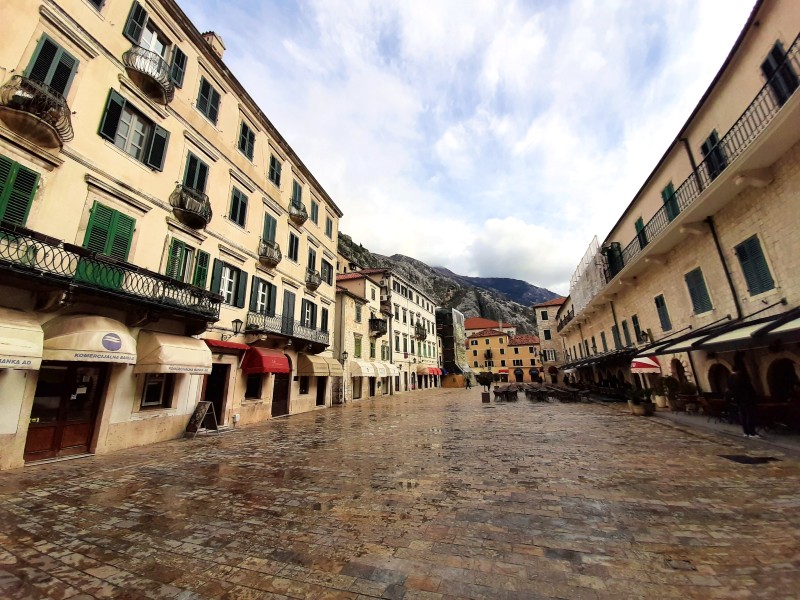
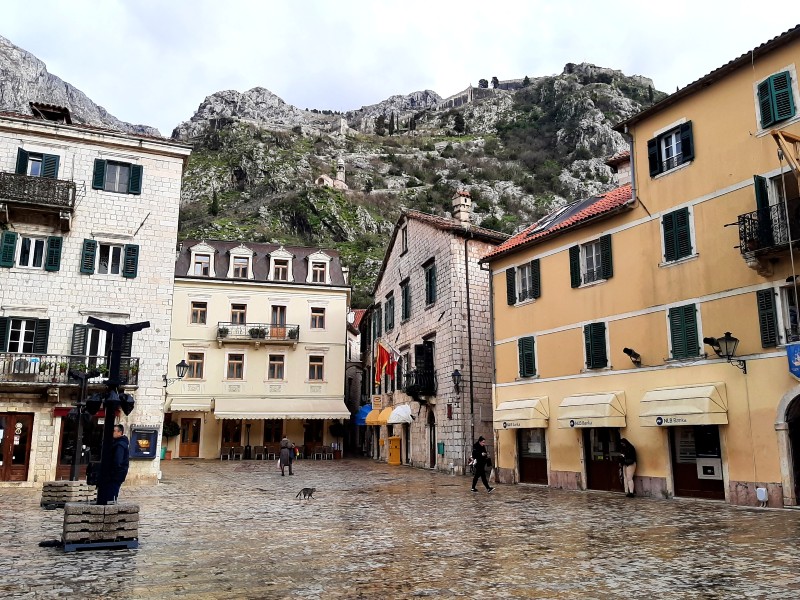
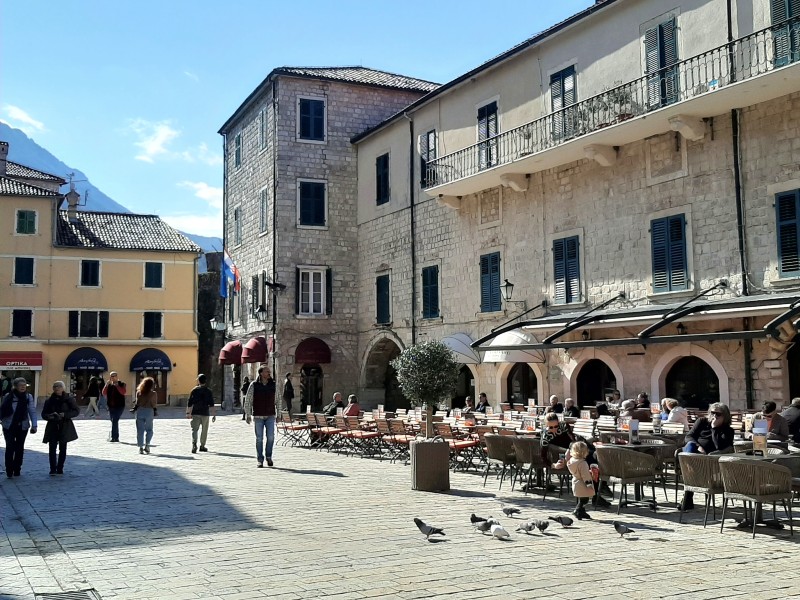
Old town churches
There are quite a few interesting churches to visit in Kotor, each of them reflecting another era of the town’s history.
The main church is without doubt the 12th century Romanesque Cathedral of Saint Tryphon, which is located on a lovely square in the southern part of the old town.
In the northern part of town you can find the Orthodox Saint Nicholas Church as well as the small Saint Clare’s Church.
This Catholic church might seem unimpressive from the outside, but behind the simple stone facade you can find a rich Venetian-era baroque interior.
Perhaps most interesting of all churches is the even smaller Church of Sveti Luka (Saint Luke’s) on the ornate Piazza Greca.
This elegant little church has the traits of both Roman and Byzantine architecture.

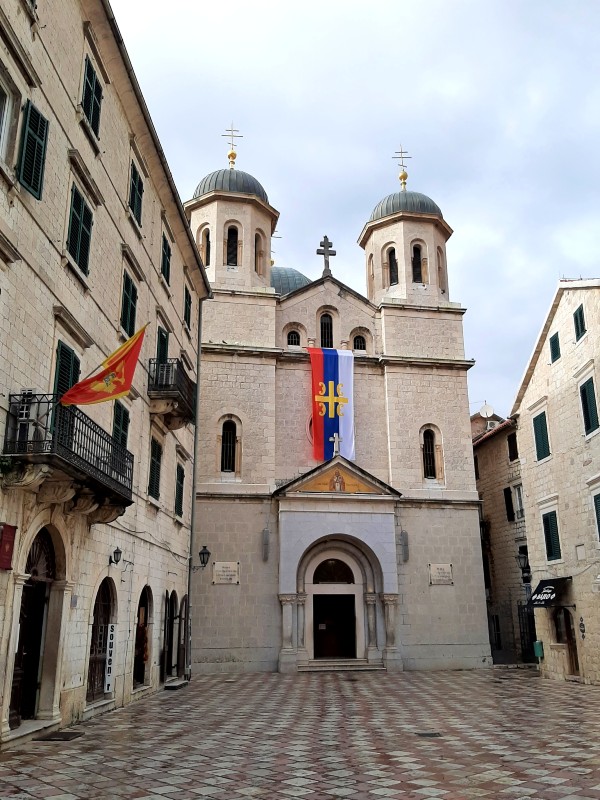

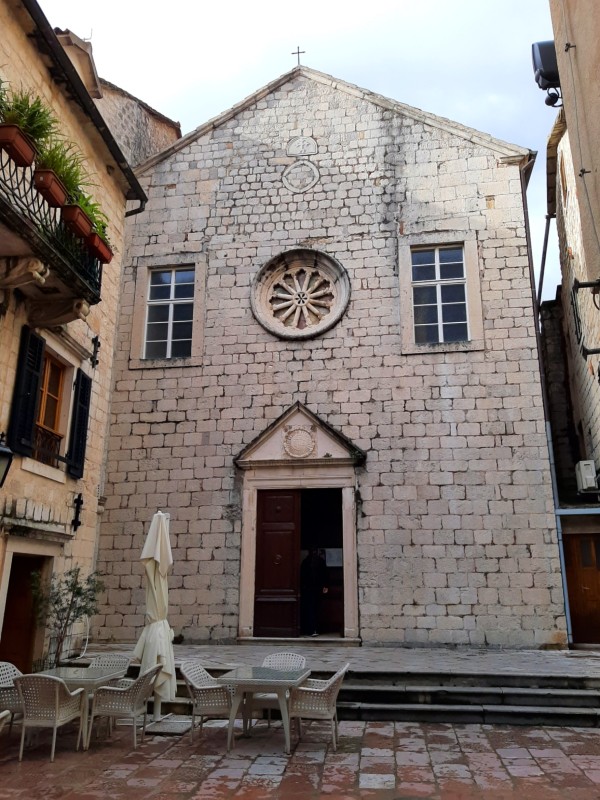

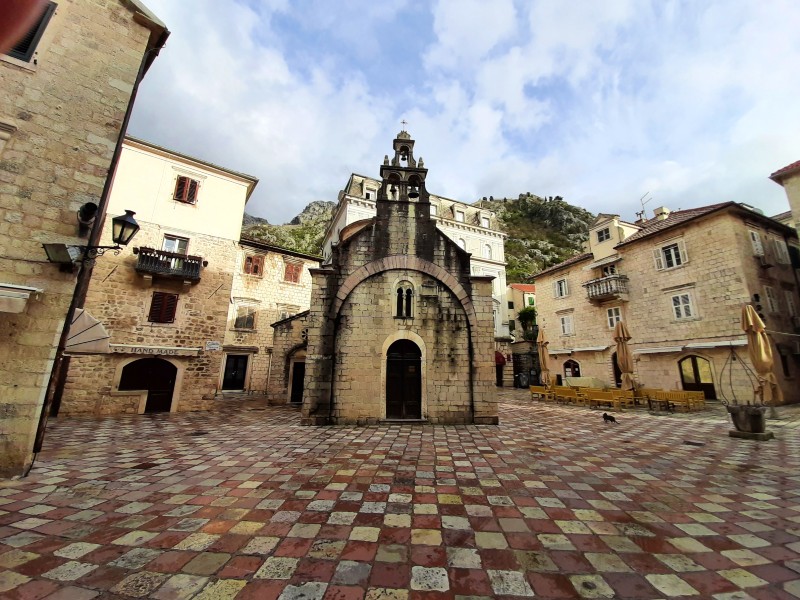
Charcoal coffee
After walking around for a while longer through the lovely backstreets of Kotor I headed to Letrika Art Cafe, a local bar/pub which was recommended by the owner of my hotel.
It is the most unique bar in Kotor and reportedly the only place in the world where you can try Medieval-style charcoal coffee.
A piece of hot charcoal is served with your coffee, which you then place inside your stone mug where you let it soak for a few minutes.
The charcoal gives the coffee a more smooth taste and texture as it takes the bitter taste out of your drink, something which was apparently required in those times due to the lack of decent espresso machines.
It is definitely a fun experience to try – and the coffee didn’t taste bad at all (although I still prefer a proper Italian espresso).
The quirky little bar seemed to be a nice place too for evening drinks. It’s definitely a nice place to seek out in Kotor.



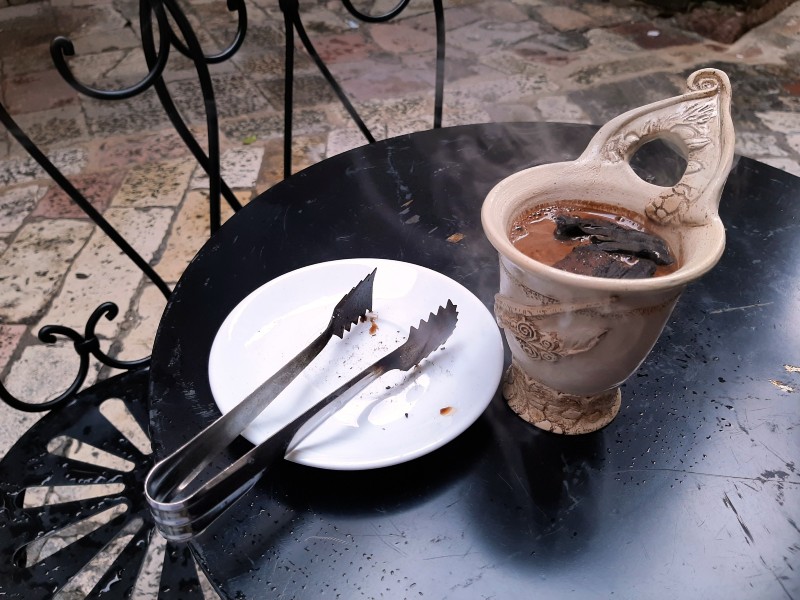

North Gate
From Letrika Art Cafe it was a short walk through some atmospheric alleys towards the north gate of the old town.
Just before you leave through this gate you will come across the small Church of St. Mary Collegiate, which was unfortunately closed when I visited.
Kotor’s Northern Gate is by far my favourite of all three city gates.
Once you take a step outside you will find yourself on a gorgeous old stone bridge spanning the fast-flowing Škurda River.
Because of this, the North Gate is also known under the names of Vrata od Škurde (Skurda Gate) or simply as the River Gate.
The bridge makes an excellent spot to admire the impressive views of the surrounding mountain landscape as well as of the defensive works of the old town such as the moat, fortified walls and bastions.
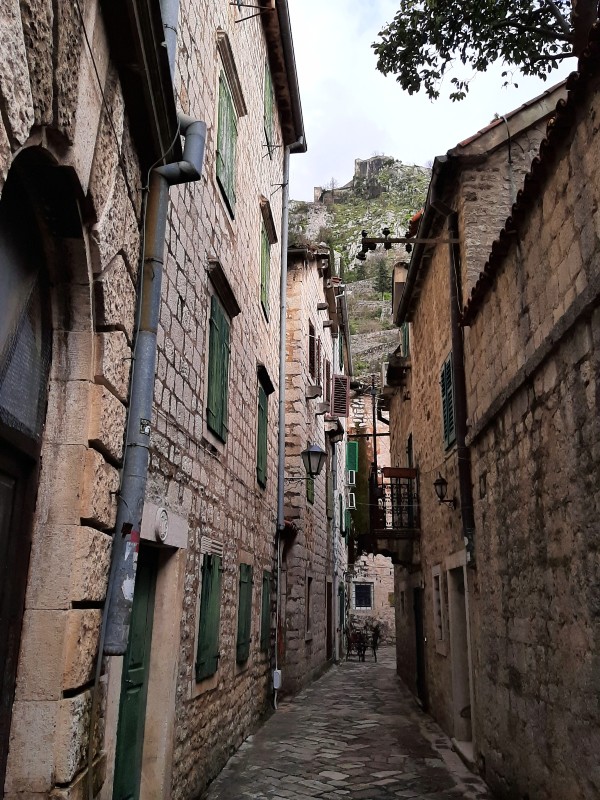

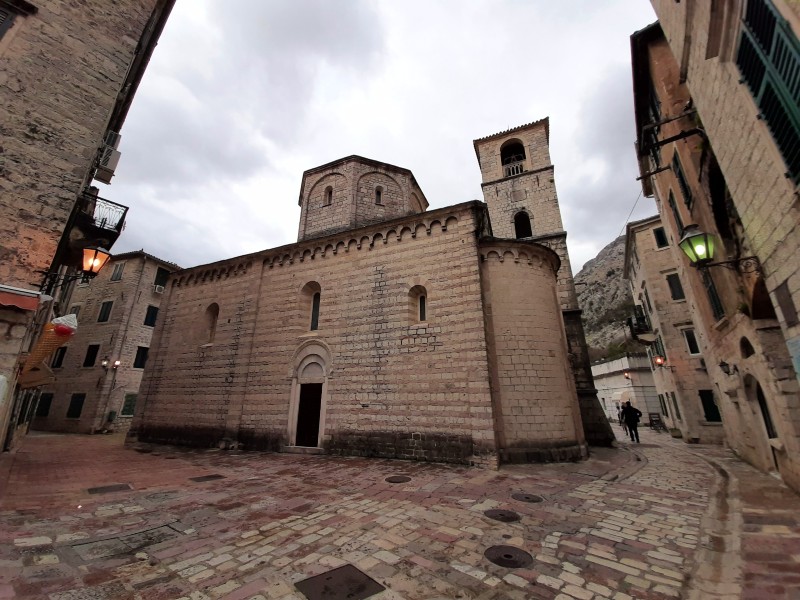
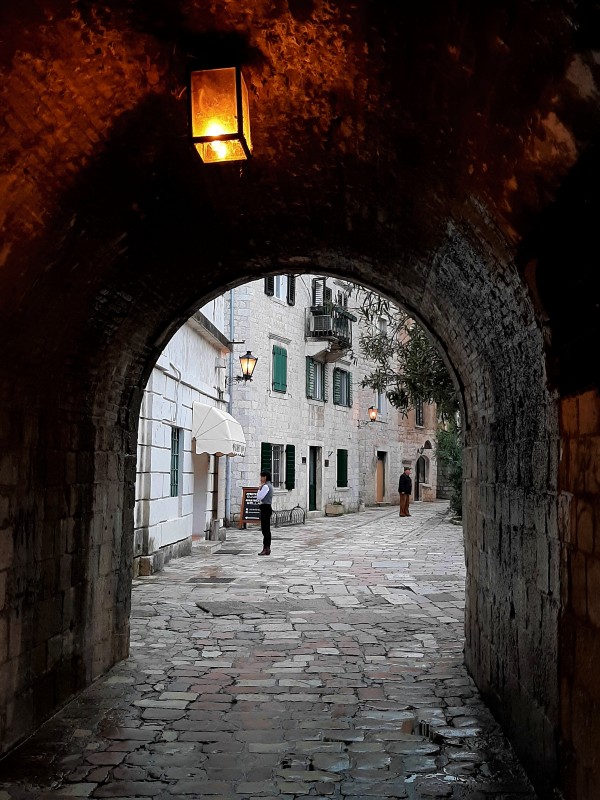

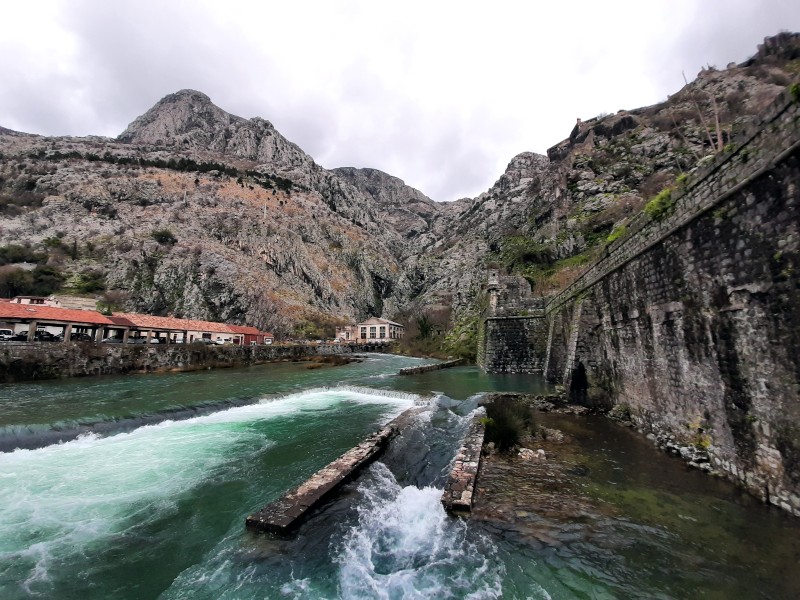





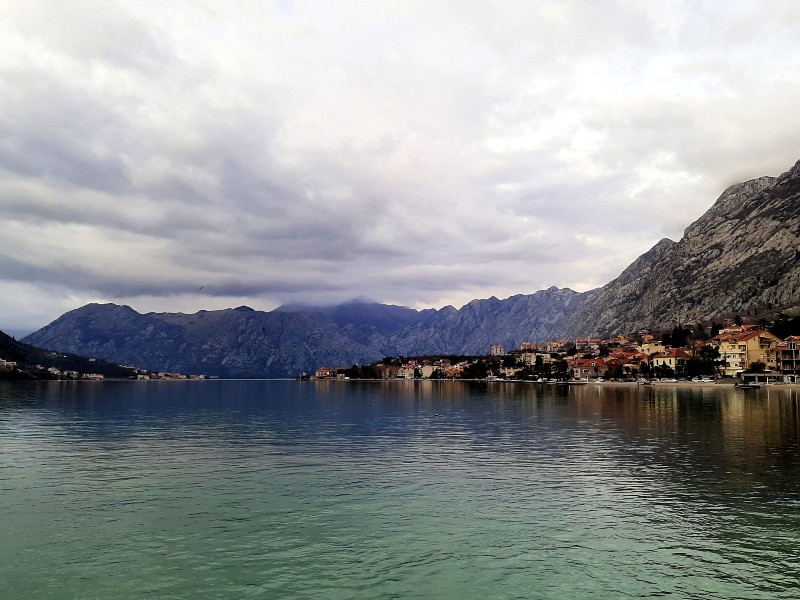
Climbing up
One of Kotor’s most impressive features is its dramatic setting at the far end of the Bay of Kotor, right at the foot of 1,749 metres (5,738 ft) high Mount Lovćen.
To really appreciate Kotor’s unique location, you have to climb up a bit, although fortunately there is no need to go all the way to the top of Mt Lovćen.
From the Church of St. Mary Collegiate there is an alley leading up on the mountain flank.
It doesn’t take long until you find yourself out of the old town on some stone steps zigzagging further up.
It takes more or less 20 to 30 minutes to reach the mountainside Church of Our Lady of Remedy, although chances are you will take longer as the views back over Kotor are simply spectacular, warranting frequent rest stops to take in the panorama.
From the Church of Our Lady of Remedy it is a further 20 to 30-minute climb up to reach the ruins of Kotor Fortress located at 280 metres above sea level.

Follow the cat
As I was visiting at the end of winter, I unfortunately did not have time to climb all the way up to the fortress this time around as limited daytime hours meant that sunset was fast approaching.
However, even if you don’t have the time (or energy) to make the entire climb to the fortress, you will still be able to enjoy some terrific views from the church or any other halfway point.
When I started my climb up at the Church of St. Mary Collegiate, I was surprised to see a cat seeking attention.
After petting the cat for a few minutes, the cute little muggy then proceeded ahead of me on the road up, pausing every 20 or so seconds to let me catch up.
Only when we reached the last town house on the mountain path, did the cat suddenly sneak into a seemingly abandoned stone house through a half-opened door.
Another cat – dressed majestically with an immaculate bow tie – then stepped out and waited in front of the door like a sort of a butler.
The bizarre scene seemed almost like out of a fantasy movie – the kind of film where you end up in a weird magical land where animals can speak if you follow the cat inside the house.
As I wasn’t sure if the house was really abandoned or people actually lived inside it, I just decided to walk on and continue with my climb up the mountain.
Writing this and looking back at the pictures, I’m still highly curious to what was actually inside the house.







Kotor Bay
During the entire climb up there are some fabulous views down over the old town of Kotor and the bay, which is often mistaken for a fjord.
The Bay of Kotor has an unique sheltered location due to the craggy mountains lining the entire bay, which form a fantastic natural defence barrier and made the port of Kotor a natural anchorage and safe haven from enemy fleets.
It also creates a humid, subtropical micro-climate which makes Kotor one of the wettest places in Europe.
Standing high up on the mountain you can clearly see where the name ‘Montenegro’ was derived from.
It were the Venetians who first gave the area this Italian name which means ‘Black Mountain’ (Monte Negro).
The name struck a chord as even the native Slavs inhabiting the area adopted the ‘Black Mountain’ name, which they translated to Crna Gora in their own Montenegrin language.
Although the weather in the high summer season is hot and dry with especially August being known for its clear blue skies, in most other months of the year there will be lots of gloomy, dark clouds which give the mountains and waters its trademark colours.
My old Lonely Planet guidebook describes the views over Kotor Bay as “all Wagnerian” – and I cannot think of a more apt description for the majestic views.
If this panoramic view would be a piece of music then Wagner’s ‘Ritt der Walküren’ (Ride of the Valkyries) definitely comes closest.
To quote Lonely Planet: “In broody weather the atmosphere becomes all Wagnerian, dark shadows cut with fingers of sunlight while on a sunny day the wind-ripples on the purple water sparkle.”
On this March day with highly changeable weather, the views and purple sunset colours couldn’t be better.
Even it this was my third visit to Kotor, it was as impressive as my first time around. Wow.

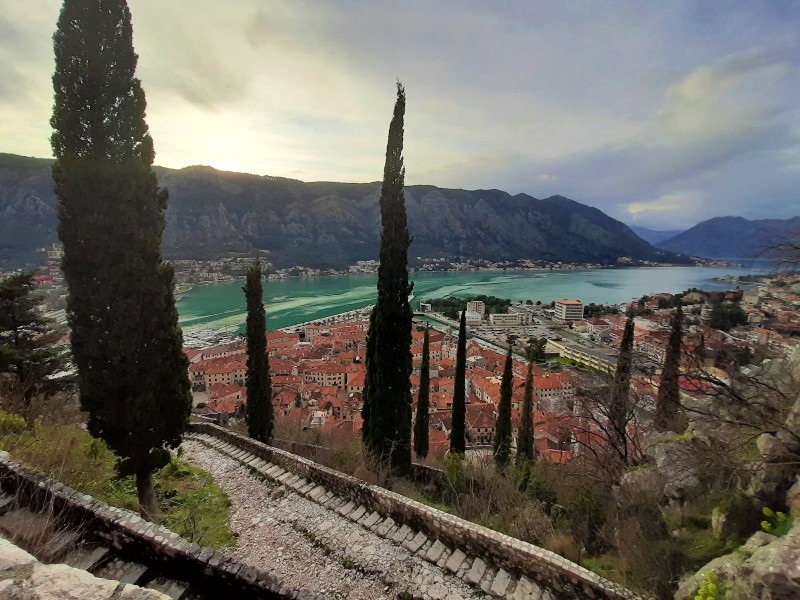





Dinnertime
Once I was safely back down (which was trickier than you think it is on the uneven cobble-stoned road) I rested a bit on a terrace drinking a beer while contemplating where to go for dinner.
On recommendation of my hotel I went to Cesarica, a family-run restaurant with a cosy, traditional interior serving authentic Montenegrin cuisine.
I went a with a tasty fish soup as starter, followed by a fish dish with a seasonal side of mashed cabbage.
It was a great meal and went very well with a local white wine. I have nothing but positive things to say about the warm, welcoming service too.
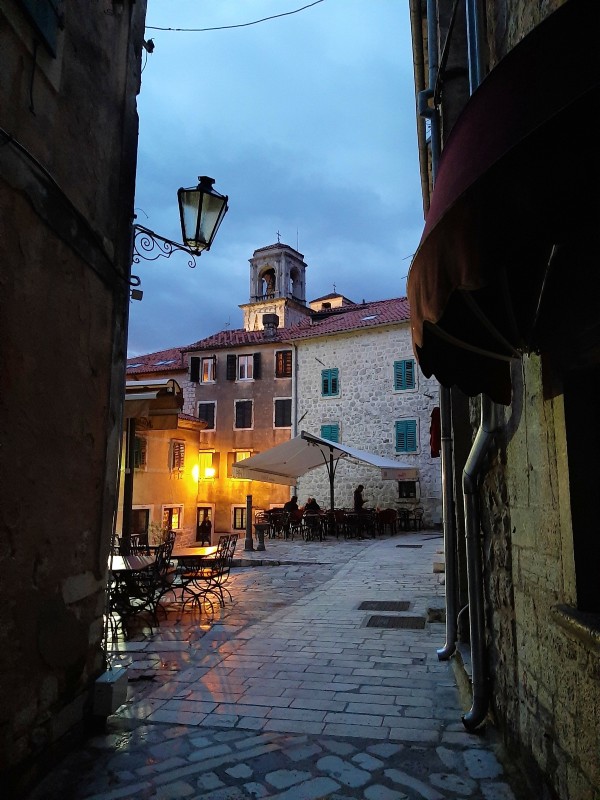

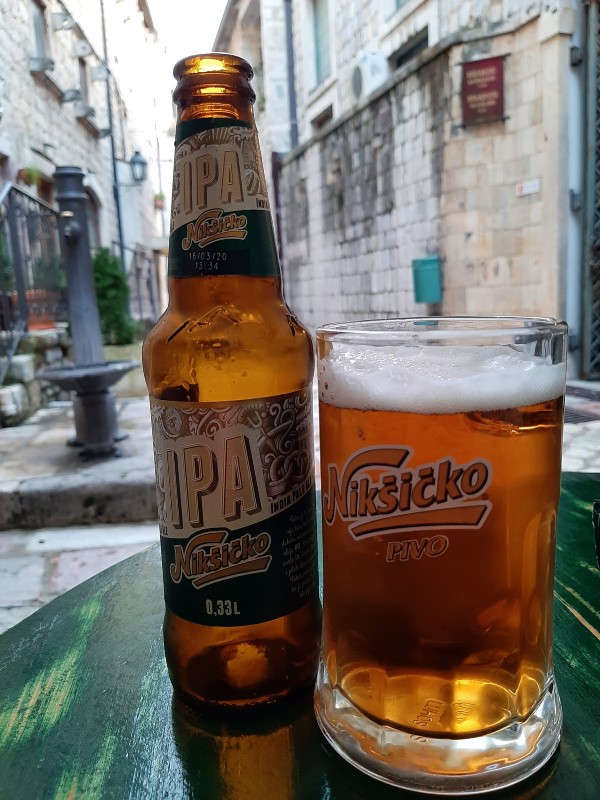
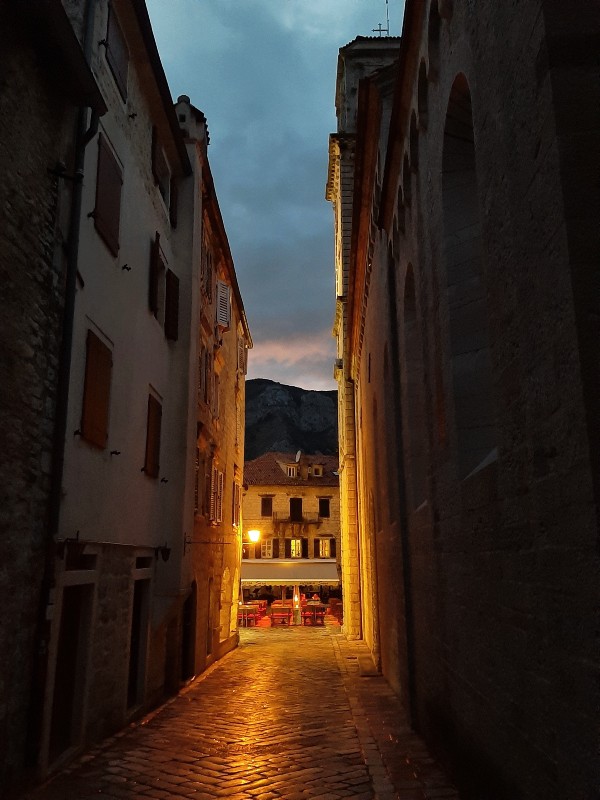

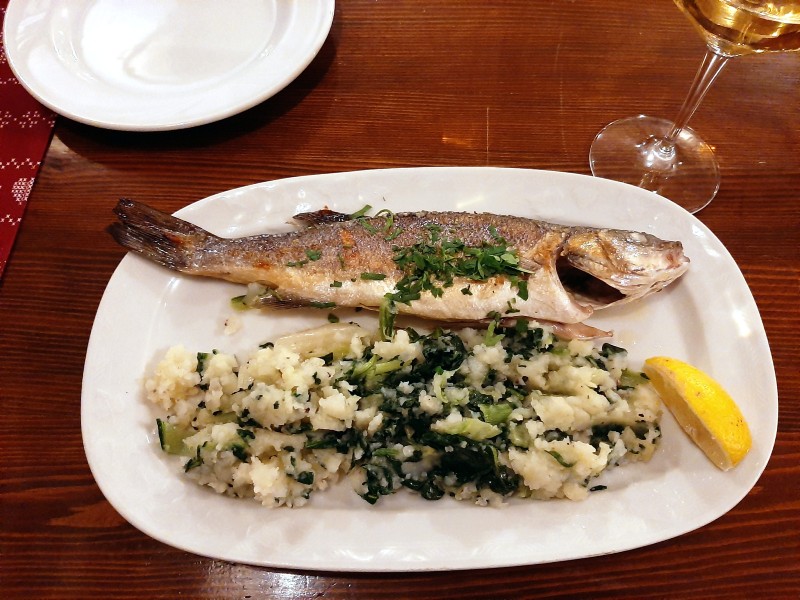

Nighttime walk
Even if you already explored Kotor’s old town by day it is well worth taking another stroll by night.
With only a few dimly-lit lights on and the crowds gone, the town has an unique atmosphere on its own in the hours of darkness.
Although there isn’t any nightlife or party atmosphere like you can find in the clubs of the nearby coastal resort of Budva, there are a few pubs spread around Kotor’s old town if you seek a nightcap or two.
I just wandered a bit around and retired back to my boutique hotel, relaxing with a glass of white wine in my room’s spa bath.
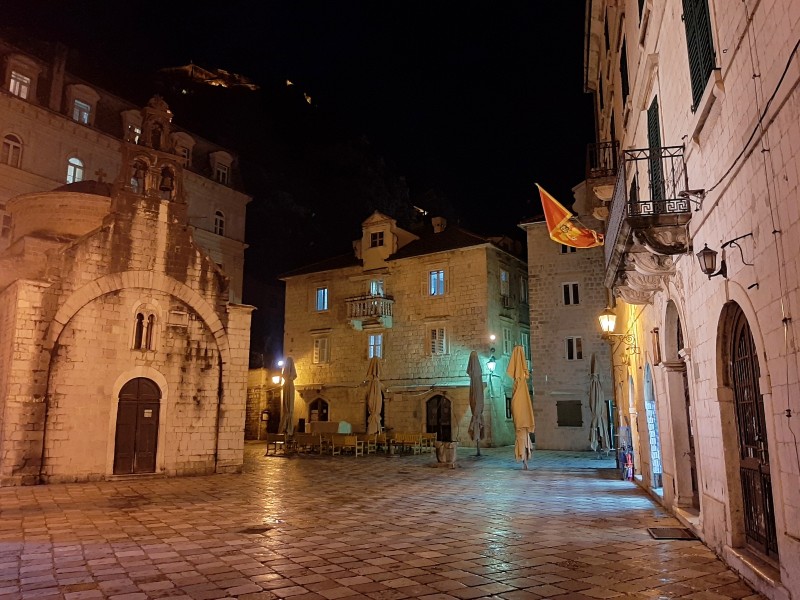
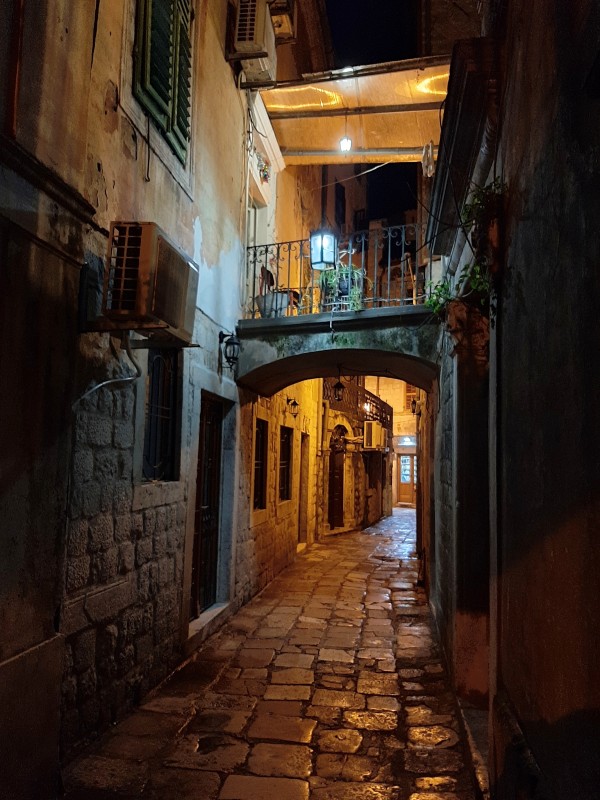


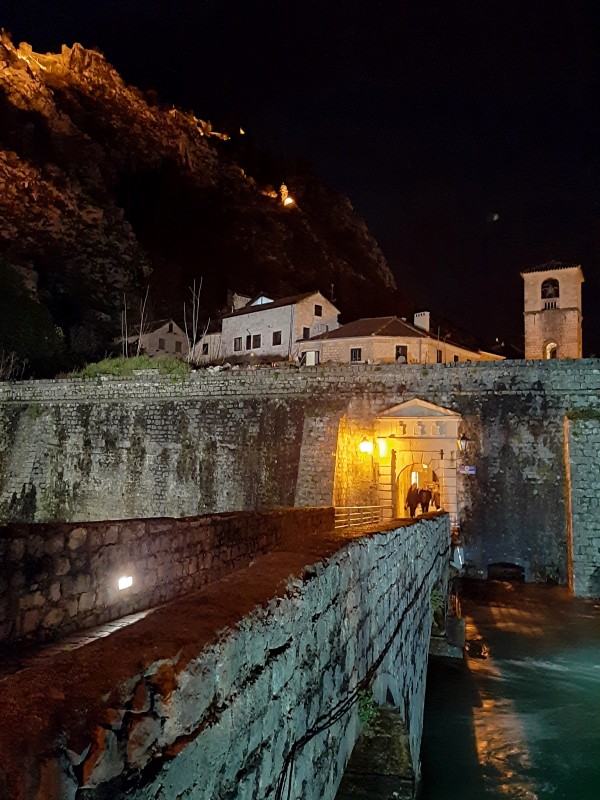
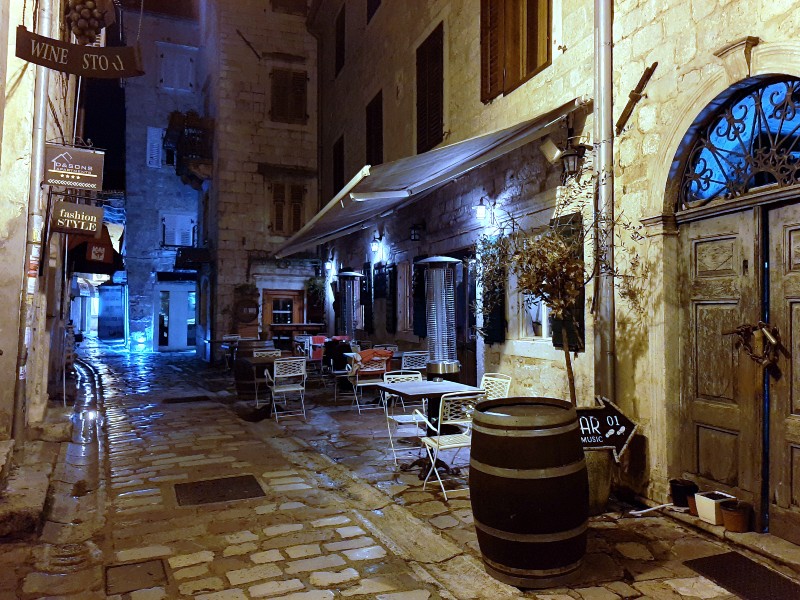
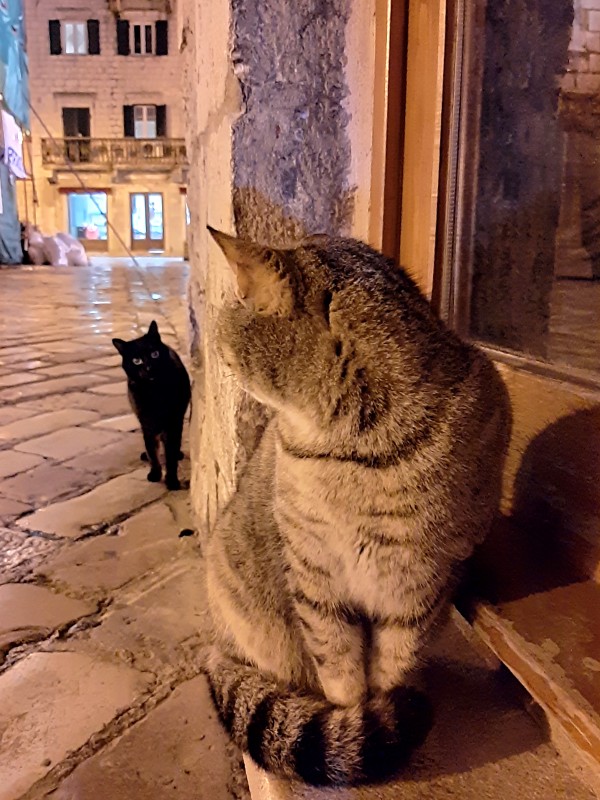

Morning
After a good night’s sleep I woke up to beautiful clear skies the following morning.
As no breakfast is served in the boutique hotel where I stayed, I headed out of the North Gate to a nearby bakery to get a typical Balkan breakfast of a cheese-filled burek with some yoghurt.
A strong espresso or good cappuccino is as much part of the daily life in Montenegro as it is in neighbouring Croatia, and there are plenty of cafes in Kotor’s old town where you can get your fill.

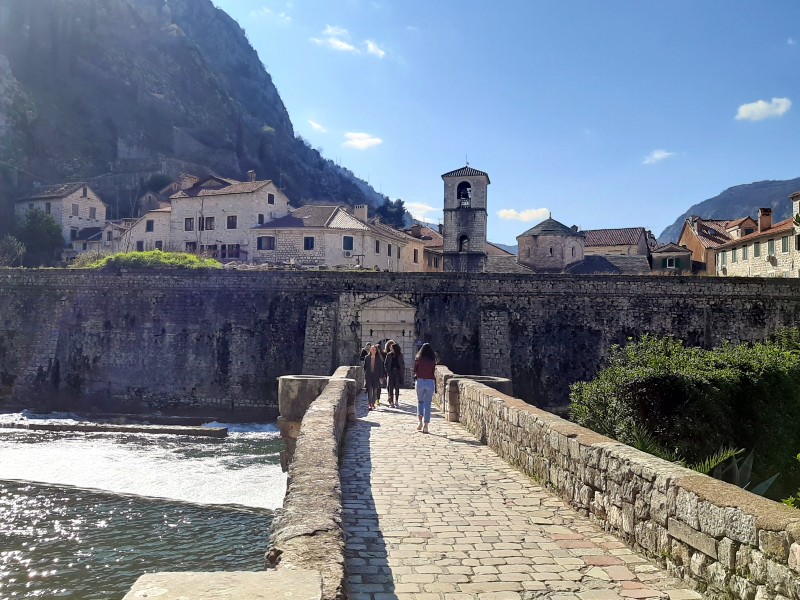

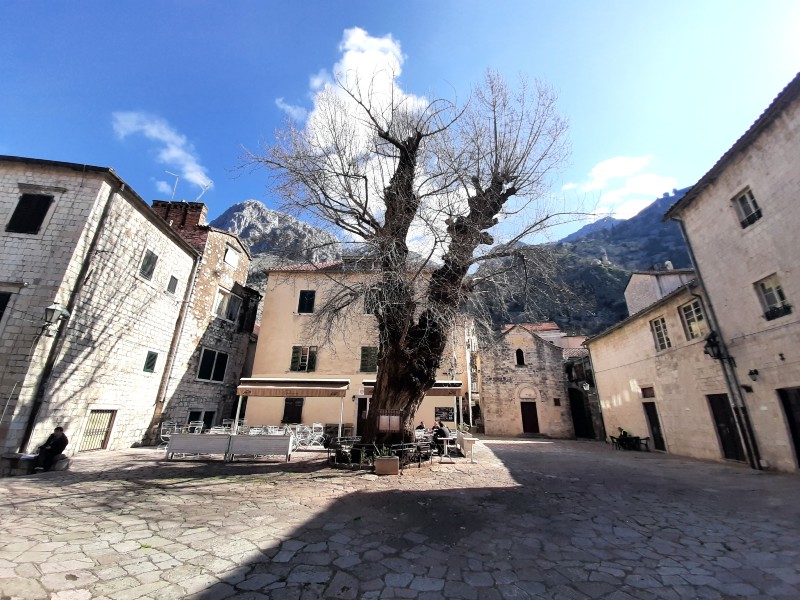

Cats of Kotor
As I had a late morning bus out of Kotor to Cetinje, I still had some time to kill after I finished my coffee.
I ended up spending it playing with the local cats.
Just like in neighbouring Dubrovnik, you will find a lot of ‘community cats’ in Kotor.
Although being stray cats, these cats are lovingly taken care after by the entire community.
Kotor is famous for its cats and features a few special cat souvenir shops and even a cat museum (which was unfortunately closed during my visit).
According to legend, the cats in the city saved the town population and the sailors multiple times from diseases such as the Black Death by eating mice and other vermin.
While other cities in the area were allegedly hit hard by such plagues, Kotor was each time miraculously spared, which started the close relationship between the community and its feline population.

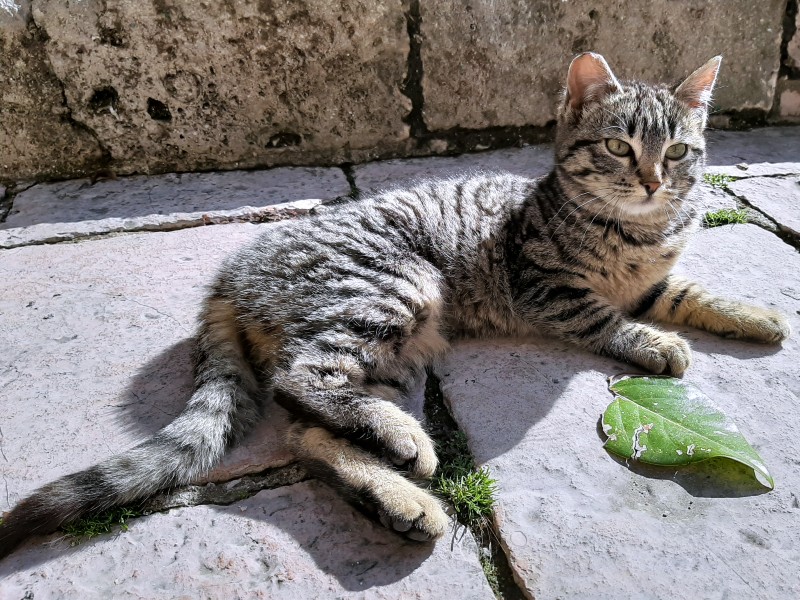
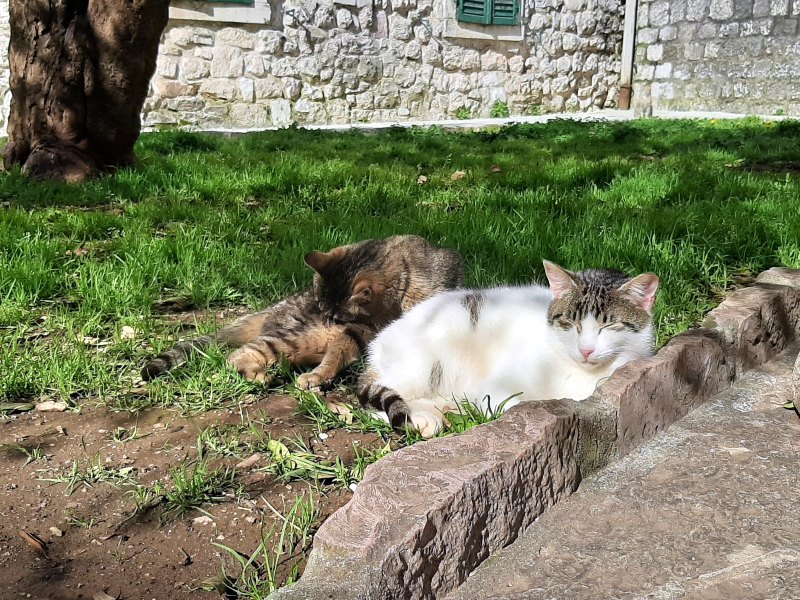
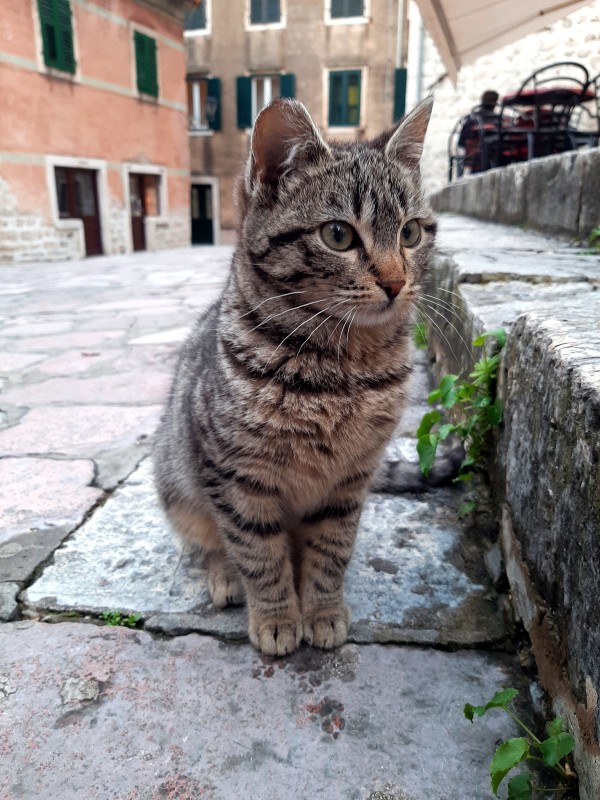


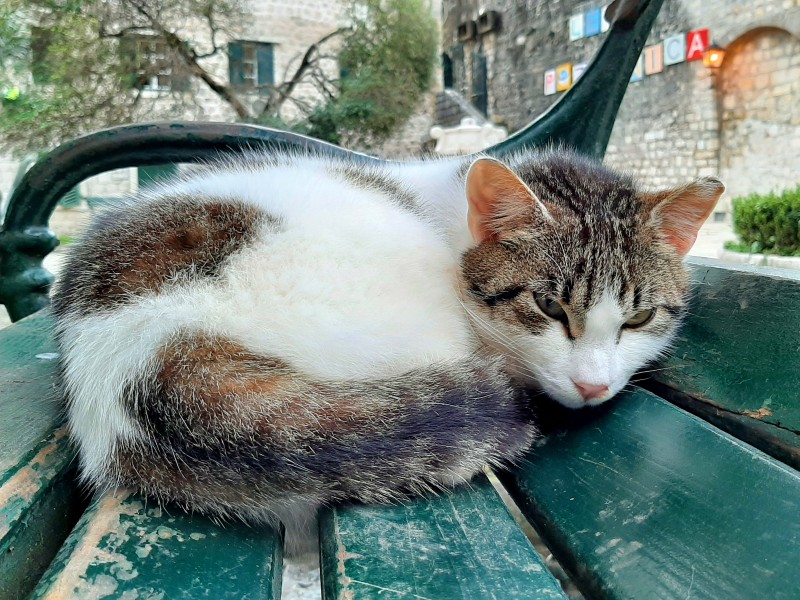

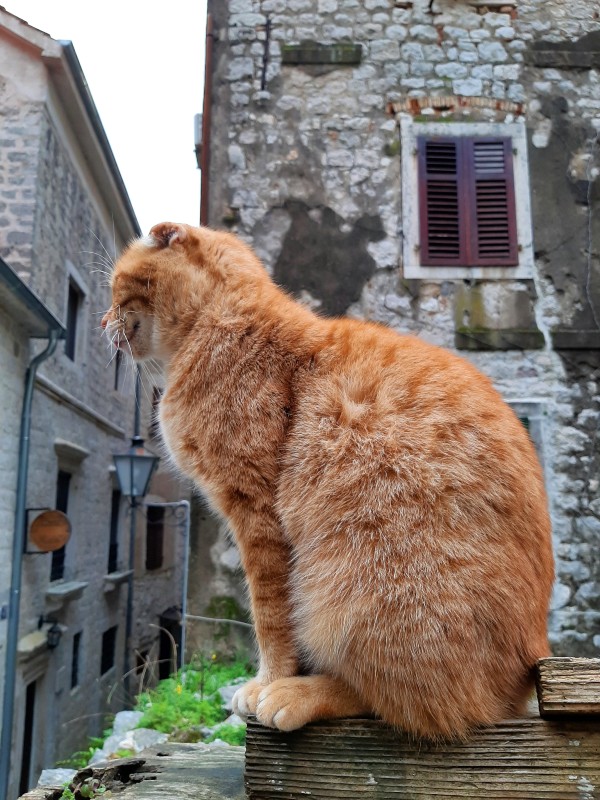


Where to stay in Kotor?
If you already read the previous chapter in this trip report it won’t come as a surprise, but I can highly recommend the Palazzo Drusko, which has to be one of Europe’s most fabulous boutique hotels.
Kotor is generally affordably priced compared, and especially when you visit in the off-season months it is possible to score some great accommodation deals.
It’s however not necessarily a must to stay inside Kotor, as the old town is easy to visit from other coastal cities in the vicinity such as Herceg Novi and Budva.
Buses along the coastal road are relatively frequent and cheap.
If you have your own wheels it’s easy to find a spot in a parking lot outside of Kotor’s old town.


How many days should I allocate for a visit to Kotor?
Although you can see the sights of Kotor (and hike up the mountain!) in half a day – you would certainly be hasting it.
I would recommend spending at least a full day in the city, which allows you to absorb the unique atmosphere and to stop a few times for a coffee, beer or meal.
There is however a lot more to see on the Montenegrin coast and in the immediate interior.
Although not as pretty as Kotor, Budva has a nice old town too and in the summer makes for a thriving beach resort.
Further down the Bay of Kotor is the old town of Perast, from where you can make a boat ride to a small island on which the Lady of the Rocks Church is built.
If you head south, the beach as Sveti Stefan is a gorgeous stop (the Sveti Stefan peninsula is unfortunately off-limits as it has been converted into a luxury Aman Hotel – with only hotel guests being allowed in).
Inland, you can find the old Montenegrin capital of Cetinje.
If you have your own car, the drive up to Cetinje from Kotor is amazingly scenic. Mount Lovćen National Park is also well-worth visiting.
If you have never visited the area before, you could therefore easily spend a full week on the coast of Montenegro as there is so much to see.
Whether you make Kotor, Budva, Herceg Novi or even Ulcinj your base, there are endless of day trip possibilities!

Trip report index
This article is part of the ‘An Adriatic Adventure: Off-Season Travel to Dubrovnik, Montenegro and a Bit of Bavaria‘ trip report, which consists of the following chapters:
1. Review: MasterCard Business Lounge Bucharest Otopeni Airport
2. Review: Aegean Airlines Economy Class Bucharest to Athens (Airbus A320)
3. Review: Aegean Business Lounge Athens Airport Hall A (Non-Schengen)
4. Review: Olympic Air Economy Class Athens to Dubrovnik (Bombardier Dash 8-400)
5. Review: Apartments Festa, Old Town of Dubrovnik
6. A Dubrovnik Winter Trip: Off-Season Travel Away from the Tourist Crowds
7. Review: Dubrovnik (Croatia) to Kotor (Montenegro) by Bus
8. Review: Palazzo Drusko Deluxe Rooms, Kotor, Montenegro
9. Kotor, Montenegro: Old Town Charm in Europe’s Most Spectacular Scenery (current chapter)
10. Cetinje – The Old Royal Capital of Montenegro
11. Review: Ramada by Wyndham Podgorica, Montenegro
12. Podgorica: Is the Capital of Montenegro Worth a Visit?
13. Review: Wizz Air Podgorica to Memmingen (Airbus A320)
14. Memmingen: More Than Just a Low-Cost Airport Close to Munich
15. The Bavaria Ticket: Unlimited Train Travel Across the German State of Bayern
16. Review: Michel Hotel Landshut, Bavaria, Germany
17. Landshut: Bavaria Off The Beaten Track
18. Review: Air France/KLM Lounge Munich Airport
19. Review: Air France Economy Class Munich to Paris CDG (Airbus A319)
20. Review: Air France Business Lounge Paris CDG Airport Terminal 2E – Hall L
21. Review: Air France Economy Class Paris CDG to Bucharest (Airbus A320)

